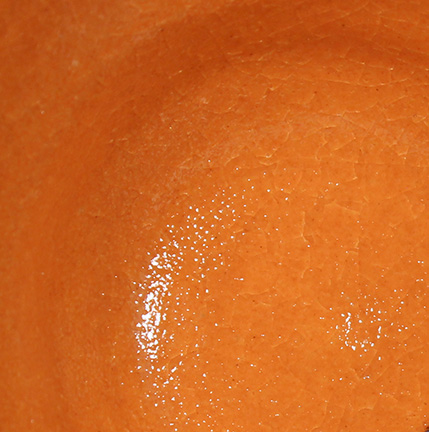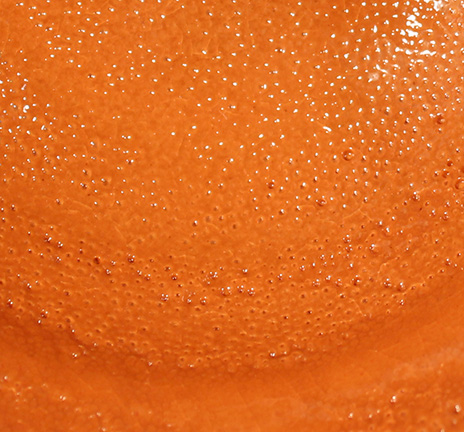High Alumina Orange
firing to cone 10 in oxidation
slow downfire at 50 deg F an hour in the interval 1850 deg F to 1700 deg F
slow downfire at 25 deg F an hour in the interval 1700 deg F to 1650 deg F
One hour hold at 1650 deg F
First Tests
 |
 |
glazes cooper_394 resp. al_2015_10_2
We compare the seger formula's of all the glazes to that of cooper_394.
The glaze cooper_394 is from Emmanuel Cooper's book "The Potter's Book of Glaze Recipes".
al_2015_10_2 has higher alkaline earths than cooper_394.
Both cooper_394 and al_2015_10_2 have a lovely orange color, and are substantially underfired.
cooper_394 has an orange peel texture and is pitted, in addition to being unacceptably crazed
for a full gloss glaze.
al_2015_10_2 is perhaps not quite as underfired as cooper_394 , yet still exhibits substantial
crazing as well as unsightly "uncolored" thick patches of the glaze. The glaze is lumpy,
another indication of its underfired state.
Section I low defect
 |
 |
 |
glazes cooper_394EPK, resp. cooper_394S, resp al_2015_10_5
Cooper_394EPK has higher alumina and silica, with a lower silica:alumina ratio.
This glaze has a smoother less pitted surface than cooper_394.
The balance of alkali metals in cooper_394S differs from that of cooper_394, primarily by substantially replacing K2O/Na2O
with Li2O.
This glaze is matured, but the color shifts toward brown.
al_2015_10_5 has lower silica and somewhat lower alkaline earths, with a shift in the alkaline earths
toward higher MgO, lower CaO than cooper_394.
This glaze is likely usable with careful control of the application thickness.
There is no pitting or orange peel texture, and the glaze is minimally crazed.
Section II Glazes with high defect
 |
 |
 |
cooper_394Red, resp al_2015_10_4, resp al_2015_10_3
cooper_394Red has higher alkali metals than cooper_394, and slightly higher silica alumina ratio.
It has good, though not spectacular color, and is equally crazed/pitted/underfired.
as cooper_394.
al_2015_10_4 had lower silica, lower alkaline earths, and a shift in balance of alkali metals
to include some lithia.
It has a slight orange peel texture together with unsightly crazing.
al_2015_10_3 has moderately lower silica and lower alkaline earths.
It has a nice color, marred by the substantial pitting with concommitent strong orange peel texture.
Commentary
These glazes all have alumina greater than 1.14, earlier work seemed to show that orange required high alumina.
It therefore isn't surprising that the lower the silica can be, the more likely the glaze is to mature.
The most underfired of these glazes have the best color.
In these small number of experiments Sodium gave a more orangy color than potassia.
The role of Lithia even in these few experiments is mixed.